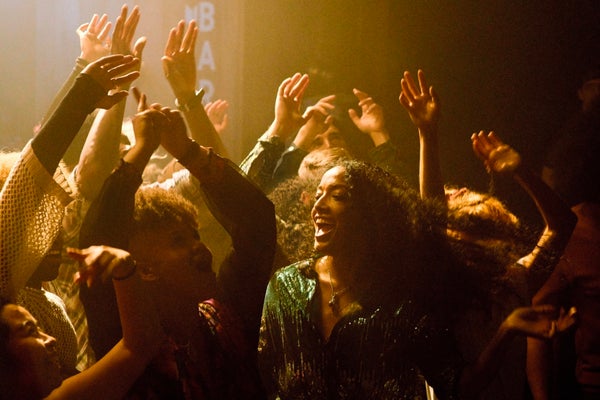
[ad_1]
Why Some Songs Makes Everyone Want to Dance
A syncopated rhythm may prompt our brain to find the beat

A group of people dancing.
Flashpop/Getty Images
Experts have gained deeper insight into why people spontaneously dance to music. That impulse to bop to the beat—what some scientists call the “groove experience”—depends on music’s degree of syncopation, a feature that affects how predictable the rhythm is, a new study finds.
The work reveals “why we cannot resist moving in sync with the beat when we listen to music with an optimal level of syncopation,” says Benoît Bardy, a professor of movement science at the University of Montpellier in France. Bardy, who was not involved in the new study, calls it “a very innovative piece of science.”
Syncopations are rhythmic patterns in which accented or unaccented beats in a melody appear in surprising places relative to the underlying beat. The more syncopation a piece of music contains, the less you can guess the rhythm of the next few bars as you listen.
On supporting science journalism
If you’re enjoying this article, consider supporting our award-winning journalism by subscribing. By purchasing a subscription you are helping to ensure the future of impactful stories about the discoveries and ideas shaping our world today.
In a series of experiments with more than 60 participants, cognitive neuroscientist Benjamin Morillon and his team from Aix-Marseille University in France uncovered how syncopation relates to the groove experience. In one study, they played 12 different melodies. The main beat was always two hertz, or roughly two events per second. But the melody’s rhythmic shifts varied so that each tune was played with three different degrees of syncopation. Participants then rated how much they wanted to dance to each track.
As Morillon and his colleagues reported in the journal Science Advances, a medium degree of syncopation triggered the strongest desire to move to the music. By contrast, neither a very high nor low degree of syncopation had that same result. In other words, people didn’t particularly want to dance to an absolutely predictable rhythm or a highly surprising one.
In addition, the groove experience seems to be all about finding the music’s underlying pulse, the study shows. When a group of study participants had to tap their finger to the beat of imagined dance steps, they did so almost exclusively to the basic 2 Hz beat, not to the melody’s rhythm.
To better understand how the brain derives these movements from the melody, Morillon and his colleagues measured brain activity in 29 people using magnetoencephalography as these participants listened to music. This analysis showed that the brain’s auditory cortex—the region that first processes auditory stimuli—primarily follows the melody’s rhythm. Meanwhile the dorsal auditory pathway, the brain area that connects the auditory cortex with movement areas, is where the rhythm apparently matches to the basic beat. It’s therefore likely that the impulse to dance arises in this pathway and is then passed on to the motor areas as a movement impulse.
The researchers also modeled their findings mathematically, with a quadratic relationship that produced an inverted U-curve where the highest desire to move came at a medium level of syncopation. That modeling, Morillon explains, revealed that a moderate level of syncopation is the point where our brain “can still extract the periodic beat from the melodies.” Putting the evidence together, he and his colleagues contend that the brain is essentially trying to anticipate upcoming beats amid a melody’s syncopation. The result is the impulse to dance.
“For a long time, music and dance have been studied separately [in the brain],” says Constantina Theofanopoulou, a neuroscientist at Rockefeller University and director of the Neurobiology of Social Communication Lab. Theofanopoulou, who did not contribute to the new study, explains that much research to date has focused on either auditory perception in music or motor production in dance. “This study takes a step towards bridging the gap between the two.” She adds that the complexity of coordinating and integrating brain areas may help to explain why rhythmic movement can be impaired in some people.
Morillon, meanwhile, explains that a key motivator for his work is understanding how people make sense of time—and how the motor system helps us recognize temporal patterns and anticipate future events. “What I find fascinating is our lack of a dedicated sense of time. We have specialized systems for processing sound and light, but time perception remains elusive.”
This article originally appeared in Spektrum der Wissenschaft and was reproduced with permission with additional reporting by Daisy Yuhas.
[ad_2]